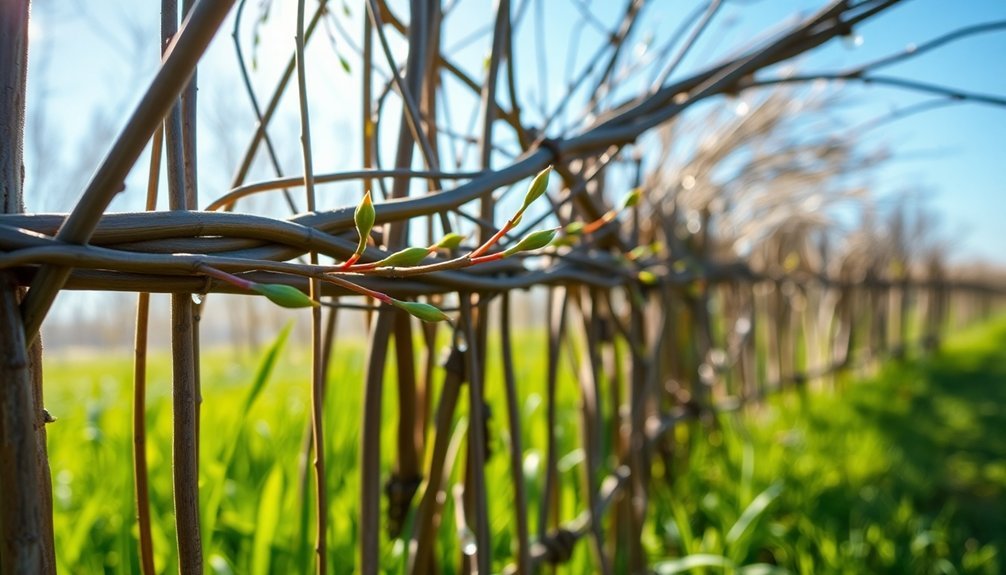The 3 best times for willow fence maintenance are early spring, mid-summer, and late autumn. In spring, prune to stimulate growth and apply linseed oil/turpentine mixture. During summer, water regularly, remove weeds, and weave new shoots for density. In autumn, apply preservative treatments to protect against winter conditions. Each seasonal maintenance approach guarantees your willow fence remains structurally sound and aesthetically pleasing throughout the year. These strategic timing practices will transform your fence's longevity.
Early Spring: Essential Renewal for Willow Fence Structure

While the winter frost recedes, early spring emerges as the perfect time to revitalize your willow fence. This season is ideal for pruning to stimulate new growth and maintain the fence's shape, setting the foundation for the growing year ahead.
Apply your protective 50:50 mixture of linseed oil and turpentine after the willow has dried, which shields it from deterioration.
Remember that willow fences need about an inch of water weekly during their first season to establish strong roots.
Check that your fence receives at least half a day of sunlight, and verify the soil isn't excessively sandy or wet.
These early spring maintenance steps provide the structural integrity necessary for your willow fence to thrive throughout the changing seasons.
If needed, this is also an excellent time to train your willow fence to achieve the desired height and form over the growing season.
Mid-Summer: Cultivating Dense Growth and Structural Integrity
When summer heat intensifies, your willow fence enters an essential growth phase requiring specific maintenance. Regular watering becomes crucial during dry spells to support robust development, especially for fences in full sun locations.
Keep the base clear of weeds to direct energy toward fence growth rather than competing plants. Instead of pruning new shoots, consider weaving them into your existing structure to create denser coverage. This technique contributes to achieving the full appearance typically seen by the end of July in the second growing season.
Check ties and supports periodically, replacing any that have weakened to prevent sections from sagging. Monitor for signs of disease or pests that might compromise structural integrity.
For aesthetic maintenance, balance growth on all sides to prevent lopsided development. Using soaker hoses on timers can efficiently meet watering needs while saving you time during the busy summer months.
Late Autumn: Preservative Treatments Before Winter Dormancy

As autumn leaves begin to fall, late October through November presents the ideal time to apply preservative treatments to your willow fence before winter dormancy sets in.
A mixture of boiled linseed oil and turpentine will protect your fence from harsh winter conditions and extend its lifespan.
Apply this treatment using a brush for better coverage or a spray bottle with slightly more turpentine for easier application.
Use a brush for thorough coverage or add extra turpentine for a spray application that reaches tight spaces.
Watch for silver or grey coloration, which indicates your fence needs treatment.
Remember that while boiled linseed oil isn't flammable in its container, rags soaked in it can spontaneously combust if left to dry.
Before winter arrives, clear surrounding vegetation, inspect for structural issues, and verify all sections are secure. Regular inspection of your fence helps to maintain rabbit and deer protection which is crucial for the long-term health of your living willow structure.
This pre-winter maintenance prevents damage from freezing temperatures and snow load.
Frequently Asked Questions
How Do I Repair a Broken Willow Fence Section?
To repair a broken willow fence section, you'll need to remove damaged branches, weave in new willow rods, secure them with wire ties, and apply linseed oil-turpentine treatment for protection once complete.
Can Willow Fences Be Relocated After Establishment?
Yes, you can relocate established willow fences, but it's challenging. Do it during dormancy (winter), prune heavily beforehand, and guarantee you dig up sufficient root mass. Expect some dieback and provide extra care afterward.
How Long Do Properly Maintained Willow Fences Typically Last?
Your properly maintained willow fence can last more than ten years. You'll extend its lifespan considerably when you regularly treat it with protective oils and guarantee quality craftsmanship from the beginning.
What Environmentally-Friendly Alternatives Exist for Traditional Preservative Treatments?
You can use natural oils like linseed or tung oil, water-based stains with no VOCs, vinegar-based cleaners, and plant-based preservatives instead of chemicals. These alternatives protect your willow fence while respecting the environment.
Are There Seasonal Color Variations in Living Willow Fences?
Yes, you'll notice striking seasonal variations in your living willow fence. Stems display vibrant winter colors, spring brings pink catkins, summer shows green foliage, and autumn delivers changing leaf hues before falling.
In Summary
By respecting your willow fence's natural growth cycle, you'll maximize its beauty and longevity. Schedule your maintenance calendar around these three critical periods: early spring renewal, mid-summer structural care, and late autumn preservation. You're not just maintaining a boundary—you're nurturing a living structure. With consistent attention during these ideal times, you'll enjoy your willow fence's natural elegance and functionality for many years.





Leave a Reply